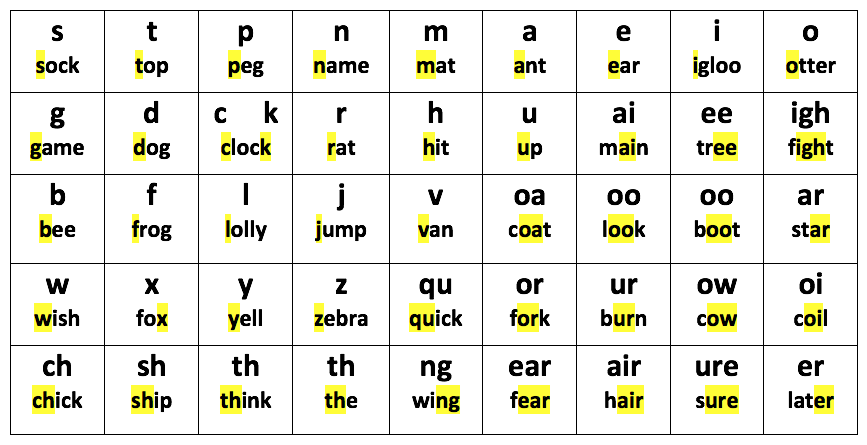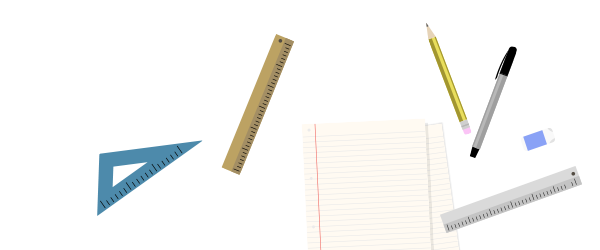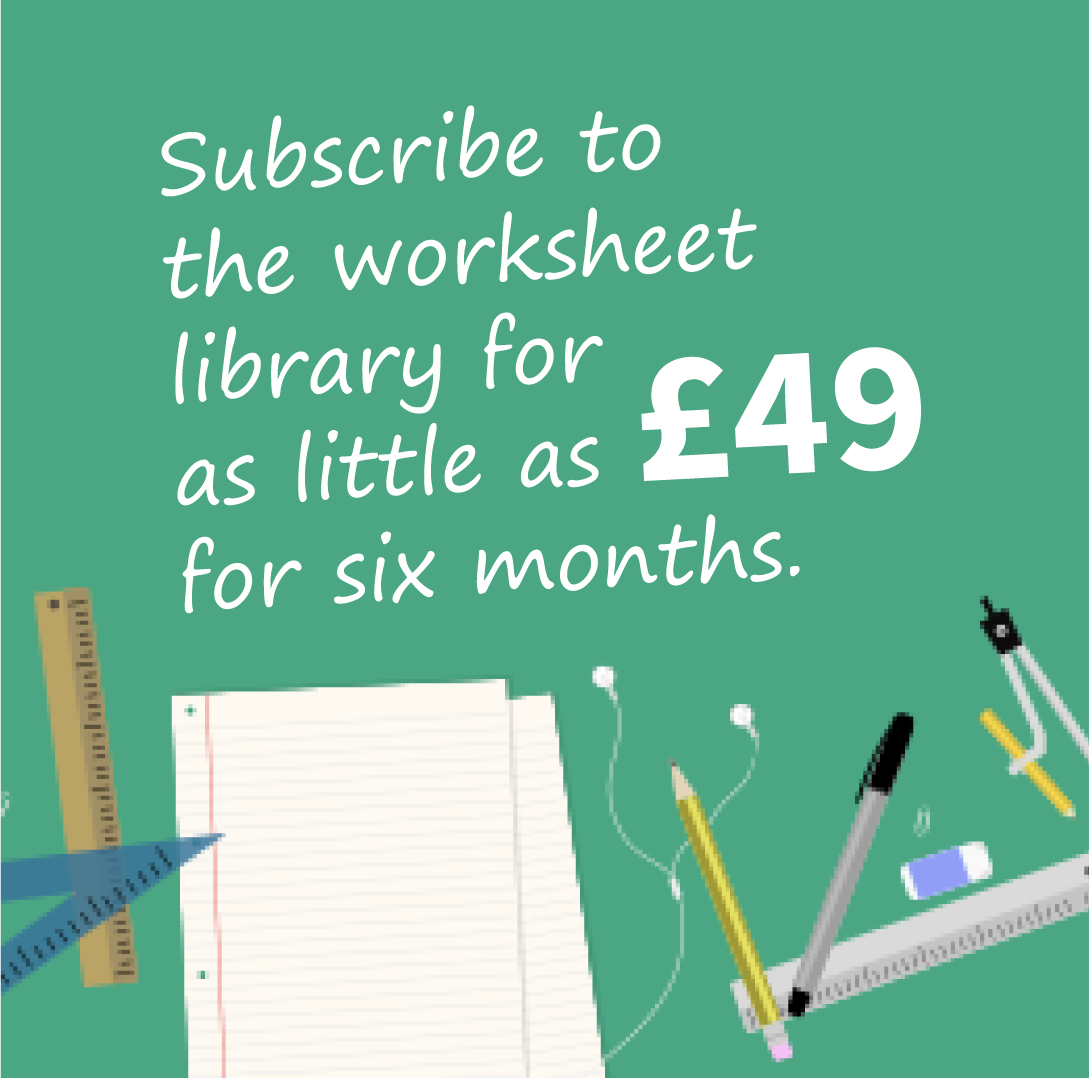What is a phoneme?
What is a phoneme? A phoneme is the smallest unit of sound in speech. There are approximately 45 phonemes in the English language, depending on different accents.
They can be put together to make words. Here is a chart of phonemes:

Phonics is the method used in schools to teach children how to read. Children will be taught to link the sounds of letters to the symbols we use to represent them, these symbols are called graphemes.
What are children taught about phonemes?
In reception, children start learning the letters of the alphabet and the sounds which the letters make. The next step involves children learning to read simple words, for example:
tap, mat, cat, pin
Teachers will help children do this by pointing to each letter of a word and getting the class to say them out loud one after the other. Then they will be taught how to blend the sounds together to make a word. For example:
The word ‘dog’ is made up of three sounds, “d”, “o” and “g”, blending these sounds together gives you the word ‘dog’. The spelling of a word and the letters it is made up of is called its phoneme sequence.
Sometimes teachers will say a simple word to the class, such as ‘tap’, and ask children to think about which sounds make up the word and what letters are needed to form it. This is known as segmenting. Children will be taught other ‘consonant-vowel-consonant’ (CVC) words, such as ‘hat’, ‘big’, and ‘fox’.
Teachers will introduce children to consonant clusters, this is when two consonants are placed together at the start or end of a word without making a new sound. For example, when saying the word ‘stop’, you say both the ‘s’ sound and the ‘t’ sound. They are blended together but no new sound is made.
Children will then move on to learning about the type of phonemes called digraphs, which are two letters placed together to make one sound. Digraphs can be vowel digraphs, such as ‘oa’ and ‘ai’, or consonant digraphs, like ‘sh’, ‘ch’ and ‘th’. Consonant digraphs are different to consonant clusters because in digraphs the two letters join to make a new sound. Children will practice blending these with other sounds to make words, such as: ‘shop’, ‘that’, ‘chat’.
Sometimes three letters are placed together to make one sound, these are called trigraphs. Examples include: ‘ear’, ‘air’ and ‘igh’.
Next, teachers will show children that some sounds can be made in more than one way, such as the long vowel sounds ‘ai’ and ‘ee’:

Children will also learn how some letters and letter combinations can make more than one sound. For example, the letter ‘y’ can act as a consonant (e.g. the word ‘yell’), or it can act as a vowel (e.g. the word ‘happy’). The letter combination ‘ch’ can also have different sounds, for example: ‘school’, ‘chef’ and ‘check’.
Lastly, children will be taught about split diagraphs (also called ‘magic e’). This means that the vowel sound in a word has been split by a consonant. For example:
‘bake’ - (the ‘ae’ make one sound but the diagraph has been split by the ‘k’).
‘home’ – (the ‘oe’ make one sound but the diagraph has been split by the ‘m’).
When a ‘magic e’ is added to the end of some 3 letter words, such as ‘hug’, the ‘e’ can reach over the consonant and change the vowel before it from a short sound to a long sound, like in the word ‘huge’.
Why is learning phonemes so important?
A good understanding of phonics is vital in helping children learn to read.
At the end of Year 1, children will have a Phonics Screening Check. This is a small assessment which will show if a child is confident in the phonics skills they have been taught so far, or if they need a bit of extra help.
The check will present children with words and ‘nonsense words’ that a teacher will ask them to read one-on-one. The nonsense words will be made up of phonic rules children have been taught and teachers will see if children can read them with the correct sounds. This will show if they understand the phonics rules. Example nonsense words might be ‘fim’, or ‘dat’.
How to help children with phonemes?
When reading with your child, it is a good idea to ask them to sound out a few new words which they come across, as it will help them practice their phonic decoding skills. If they are struggling to sound out the word, you could ask them to write it down on a piece of paper and then mark under each sound with a line or a dot. For example:

This exercise will help children practice blending individual sounds together. If children struggle to hear all the sounds in a word, encourage them to think about the movements that their mouths are making. Looking in mirrors can help with this.
It can also help children if they draw pictures of a familiar image which sound like the phoneme sound. For example, they could draw a bee to represent the phoneme ‘z’, as it sounds like the noise made by a buzzing bee. Drawing pictures will help make phonemes more memorable for children.
How does Learning Street help children with phonemes?
By introducing children to new words through spelling groups among other methods, it allows them to breakdown the word in order to understand, helping them to practice their phonemes. Also, through the use of paired reading in our course, you are able to help them practice their phonic decoding skills with any words they don’t know, helping them with their phonemes.
With a test at the end of year 1, and the skill vital in helping children learn to read, it is important that children have a good understanding of phonemes.
Our Courses
Click through to review the courses we have available
- Independent School 11 Plus Exam Preparation Courses
- Grammar School 11 Plus Exam Preparation Courses
- Primary School Improvement/Development Courses
Our 11 Plus Mock Exam Papers
Berkshire Reading 11 Plus Mock Exam Papers
Kendrick 11 Plus Mock Exam Papers Bundle ( packs 1-4)
Reading School ( FSCE) 11 Plus Mock Exam 1
Reading School ( FSCE) 11 Plus Mock Exam 2
Reading School ( FSCE) 11 Plus Mock Exam 3
Reading School ( FSCE) 11 Plus Mock Exam 4
Reading School ( FSCE) 11 Plus Mock Exam Papers Bundle (packs 1-4)
Berkshire Slough 11 Plus Mock Exams
Slough 11 Plus Mock Exam Papers Bundle (Packs 1-4)
Barnet 11 Plus Mock Exams
Henrietta Barnett 11 Plus Mock Exam 1
Henrietta Barnett 11 Plus Mock Exam 2
Henrietta Barnett 11 Plus Mock Exam 3
Henrietta Barnett 11 Plus Mock Exam 4
Henrietta Barnett 11 Plus Mock Exam Papers Bundle ( Packs 1-4)
QE Boys 11 Plus Mock Exam Papers Bundle (packs 1-4)
Bexley 11 Plus Mock Exams
Bexley 11 Plus Mock Exam Papers Bundle (packs 1-4)
Bromley 11 Plus Mock Exams
Newstead Wood School Mock Exam 1
Newstead Wood School Mock Exam 2
Newstead Wood School Mock Exam 3
Newstead Wood School Mock Exam 4
Newstead Wood School Mock Exam Papers Bundle ( Packs 1-4)
St Olave’s Grammar School Mock Exam 1
St Olave’s Grammar School Mock Exam 2
St Olave’s Grammar School Mock Exam 3
St Olave’s Grammar School Mock Exam 4
St Olave’s Grammar School Mock Exam Papers Bundle (Packs1-4)
Bucks 11 Plus Mock Exams
Bucks 11 Plus Mock Exam Papers Bundle (packs 1-4)
Cumbria 11 Plus Mock Exams
Queen Elizabeth’s Grammar School 11 Plus Mock Exam 1
Queen Elizabeth’s Grammar School 11 Plus Mock Exam 2
Queen Elizabeth’s Grammar School 11 Plus Mock Exam 3
Queen Elizabeth’s Grammar School 11 Plus Mock Exam 4
Queen Elizabeth’s Grammar School 11 Plus Mock Exam Papers Bundle (Packs 1-4)
Devon and Torbay 11 Plus Mock Exams
Devon and Torbay 11 Plus Mock Exam 1
Devon and Torbay 11 Plus Mock Exam 2
Devon and Torbay 11 Plus Mock Exam 3
Devon and Torbay 11 Plus Mock Exam 4
Devon and Torbay 11 Plus Mock Exam Papers Bundle (packs 1-4)
Colyton School FSCE 11 Plus Mock Exam 1
Colyton School FSCE 11 Plus Mock Exam 2
Colyton School FSCE 11 Plus Mock Exam 3
Colyton School FSCE 11 Plus Mock Exam 4
Colyton School FSCE 11 Plus Mock Exam Papers Bundle ( packs 1-4)
Dorset 11 Plus Mock Exams
Dorset 11 Plus Mock Exam Papers Bundle (packs 1-4)
Enfield 11 Plus Mock Exams
The Latymer School 11 Plus Mock Exam 1
The Latymer School 11 Plus Mock Exam 2
The Latymer School 11 Plus Mock Exam 3
The Latymer School 11 Plus Mock Exam 4
The Latymer School 11 Plus Mock Exam Papers Bundle ( packs 1-4)
Essex CSSE and FSCE 11 Plus Mock Exams
Essex CSSE 11 Plus Mock Exam 1
Essex CSSE 11 Plus Mock Exam 2
Essex CSSE 11 Plus Mock Exam 3
Essex CSSE 11 Plus Mock Exam 4
Essex CSSE 11 Plus Mock Exam Papers Bundle (packs 1-4)
Chelmsford County High School for Girls FSCE 11 Plus Mock Exam 1
Chelmsford County High School for Girls FSCE 11 Plus Mock Exam 2
Chelmsford County High School for Girls FSCE 11 Plus Mock Exam 3
Chelmsford County High School for Girls FSCE 11 Plus Mock Exam 4
Chelmsford County High School for Girls FSCE 11 Plus Mock Exam Papers Bundle ( packs 1-4)
Gloucestershire 11 Plus Mock Exams
Gloucestershire 11 Plus Mock Exam 1
Gloucestershire 11 Plus Mock Exam 2
Gloucestershire 11 Plus Mock Exam 3
Gloucestershire 11 Plus Mock Exam 4
Gloucestershire 11 Plus Mock Exam Papers Bundle (Packs 1-4)
Hertfordshire 11 Plus Mock Exams
Dame Alice Owen’s 11 Plus Mock Exam 1
Dame Alice Owen’s 11 Plus Mock Exam 2
Dame Alice Owen’s 11 Plus Mock Exam 3
Dame Alice Owen’s 11 Plus Mock Exam 4
Dame Alice Owen’s 11 Plus Mock Exam Papers Bundle (Packs 1-4)
Hertfordshire Southwest 11 Plus Mock Exams
Hertfordshire South West 11 Plus Mock Exam 1
Hertfordshire South West11 Plus Mock Exam 2
Hertfordshire South West11 Plus Mock Exam 3
Hertfordshire South West 11 Plus Mock Exam 4
Hertfordshire South West 11 Plus Mock Exam Papers Bundle (Packs 1-4)
Kent 11 Plus Mock Exams
Kent 11 Plus Mock Exam Papers Bundle (packs 1-4)
Kent Medway 11 Plus Mock Exams
Kent Medway 11 Plus Mock Exam 1
Kent Medway 11 Plus Mock Exam 2
Kent Medway 11 Plus Mock Exam 3
Kent Medway 11 Plus Mock Exam 4
Kent Medway 11 Plus Mock Exam Papers Bundle (packs 1-4)
Kingston-Upon-Thames 11 Plus Mock Exams
Stage 1 Tiffin 11 Plus Mock Exam 1
Stage 1 Tiffin 11 Plus Mock Exam 2
Stage 1 Tiffin 11 Plus Mock Exam 3
Stage 1 Tiffin 11 Plus Mock Exam 4
Stage 1 Tiffin 11 Plus Mock Exam Papers Bundle (Packs 1-4)
If a pupil passes the stage 1 process, they will be invited back to take a second test.
Stage 2 Tiffin 11 Plus Mock Exam 1
Stage 2 Tiffin 11 Plus Mock Exam 2
Stage 2 Tiffin 11 Plus Mock Exam 3
Stage 2 Tiffin 11 Plus Mock Exam 4
Stage 2 Tiffin 11 Plus Mock Exam Bundle (Packs 1-4)
Lancashire 11 Plus Mock Exams
Lancashire 11 Plus Mock Exam 1
Lancashire 11 Plus Mock Exam 2
Lancashire 11 Plus Mock Exam 3
Lancashire 11 Plus Mock Exam 4
Lancashire 11 Plus Mock Exam Papers Bundle (packs 1-4)
Lincolnshire 11 Plus Mock Exams
Lincolnshire 11 Plus Mock Exam 1
Lincolnshire 11 Plus Mock Exam 2
Lincolnshire 11 Plus Mock Exam 3
Lincolnshire 11 Plus Mock Exam 4
Lincolnshire 11 Plus Mock Exam Papers Bundle (packs 1-4)
Redbridge 11 Plus Mock Exams
Redbridge 11 Plus Mock Exam Papers Bundle (packs 1-4)
Sutton 11 Plus Mock Exams
Sutton 11 Plus Mock Exam Papers Bundle (packs 1-4)
If a pupil passes stage 1, they will be invited back to take a stage 2 test.
Stage 2 Sutton 11 Plus Mock Exam 1
Stage 2 Sutton 11 Plus Mock Exam 2
Stage 2 Sutton 11 Plus Mock Exam 3
Stage 2 Sutton 11 Plus Mock Exam 4
Stage 2 Sutton 11 Plus Mock Exam Papers Bundle (packs 1-4)
Trafford 11 Plus Mock Exams
Trafford 11 Plus Mock Exam Bundle (Packs 1-4)
West Midlands 11 Plus Mock Exams
West Midlands 11 Plus Mock Exam 1
West Midlands 11 Plus Mock Exam 2
West Midlands 11 Plus Mock Exam 3
West Midlands 11 Plus Mock Exam 4
West Midlands 11 Plus Mock Exam Papers Bundle (packs 1-4)
Wiltshire 11 Plus Mock Exams
Bishop Wordsworth’s 11 Plus Mock Exam 1
Bishop Wordsworth’s 11 Plus Mock Exam 2
Bishop Wordsworth’s 11 Plus Mock Exam 3
Bishop Wordsworth’s 11 Plus Mock Exam 4
Bishop Wordsworth’s 11 Plus Mock Exam Papers Bundle (packs 1-4)
South Wilts 11 Plus Mock Exam 1
South Wilts 11 Plus Mock Exam 2
South Wilts 11 Plus Mock Exam 3
South Wilts 11 Plus Mock Exam 4
South Wilts 11 Plus Mock Exam Papers Bundle (packs 1-4)
Wirral 11 Plus Mock Exams
Wirral 11 Plus Mock Exam Papers Bundle (Packs 1-4)
Upton Hall School Mock Exam Papers Bundle (Packs 1&2)
Yorkshire Calderdale 11 Plus Mock Exams
Yorkshire Calderdale 11 Plus Mock Exam 1
Yorkshire Calderdale 11 Plus Mock Exam 2
Yorkshire Calderdale 11 Plus Mock Exam 3
Yorkshire Calderdale 11 Plus Mock Exam 4
Yorkshire Calderdale 11 Plus Mock Exam Papers Bundle (packs 1-4)
Yorkshire-North 11 Plus Mock Exams
Erymsted’s 11 Plus Mock Exam 1
Erymsted’s 11 Plus Mock Exam 2
Erymsted’s 11 Plus Mock Exam 3
Erymsted’s 11 Plus Mock Exam 4
Erymsted’s 11 Plus Mock Exam Papers Bundle (Packs 1-4)
Ripon Grammar School 11 Plus Mock Exam 1
Ripon Grammar School 11 Plus Mock Exam 2
Ripon Grammar School 11 Plus Mock Exam 3
Ripon Grammar School 11 Plus Mock Exam 4
Ripon Grammar School 11 Plus Mock Exam Papers Bundle ( Packs 1-4)
Skipton Girls’ High School 11 Plus Mock Exam 1
Skipton Girls’ High School 11 Plus Mock Exam 2
Skipton Girls’ High School 11 Plus Mock Exam 3
Skipton Girls’ High School 11 Plus Mock Exam 4
Skipton Girls’ High School 11 Plus Mock Exam Papers Bundle (Packs 1-4)
Independent School Mock Exams
Independent School 11 Plus Mock Exam 1
Independent School 11 Plus Mock Exam 2
Independent School 11 Plus Mock Exam 3
Independent School 11 Plus Mock Exam 4
Independent School 11 Plus Mock Exam Papers Bundle (Packs 1-4)
Northern Ireland Transfer Test
Northern Ireland Transfer Test Mock Exam Paper 1
Northern Ireland Transfer Test Mock Exam Paper 2
Northern Ireland Transfer Test Mock Exam Papers 1-4 Bundle
Northern Ireland Transfer Test Mock Exam Papers 5-8 Bundle
Our Worksheets
We have over ten thousand worksheets listed that can be drawn on to focus on any area of primary school development. We have broken these down into subject and school year.



